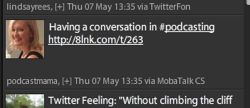Latest News
Free Webcast Offers Latest Research On The Podcast Consumer
May 12th, 2009 | By Elisabeth Lewin | Category: New Media Organizations, Podcasting, Podcasting Statistics  The Association for Downloadable Media and Edison Research are pairing up to present a free online Webcast covering the latest reasearch on the audience for podcasts.
The Association for Downloadable Media and Edison Research are pairing up to present a free online Webcast covering the latest reasearch on the audience for podcasts.
Tom Webster from Edison Research will present The Podcast Consumer Revealed – 2009, on May 21, 2009, at 1:00 EST. In the Webcast, Webster will discuss the fourth iteration of Edison’s podcast research. The event is free, but requires pre-registration at this link.
Edison’s latest report offers some good news for podcasters, including proof of podcasting’s steady growth:
- Awareness of podcasting has increased from 37% to 43%; and
- The percentage of Americans who have ever listened to an audio podcast has grown to 22%.
“If you are in the business of creating downloadable media, this is key, significant research that you won’t want to miss,” says Webster, “This report and webcast will look at demographics and usage, key audience behaviors, content preferences, and attitudes towards advertising and sponsorships.”
The webcast will last one hour and will include time for your questions. Participants will also be able to download the presentation prior to its wider public release.
Details on the webcast are available at http://www.downloadablemedia.org.
Image: Ronan_tlv
Video Search EveryZing Nabs $8.25 M Funding, Inks NBCU Deal
May 12th, 2009 | By Elisabeth Lewin | Category: Making Money with Podcasts, Podcasting, Podcasting Software, Video  Remember PodZinger? They were an early entrant into the “make money with podcasting” scene, with a “speech-to-text” technology (developed by BBN Technologies in about 2006). The idea was to convert, without an expensive (human) transcription service, a podcast audio file into a text file — which, in turn, would help search engines to find the subject and content of your podcast.
Remember PodZinger? They were an early entrant into the “make money with podcasting” scene, with a “speech-to-text” technology (developed by BBN Technologies in about 2006). The idea was to convert, without an expensive (human) transcription service, a podcast audio file into a text file — which, in turn, would help search engines to find the subject and content of your podcast.
On Monday, the company announced a third round of VC funding, this batch being $8.25 million, of which $3 million comes from NBC Universal. Paid Content.org, via the Washington Post, tallies the total amount of money raised to date by PodZinger — rechristened EveryZing in 2007 — at “about $22 million.” (Wow.)
Originally launched as a help to pair relevant advertising with related podcasts, EveryZing creates rich metadata across all kinds of media — text, images, audio, and video content. It automatically tags all content, and indexes it for use with its own white-label search products, to optimize results on online search. As EveryZing, the company specializes in “video discovery and engagement for premium content.”
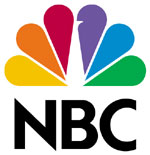 While the funding round is notable in itself, of greater interest is the involvement of NBC Universal in the deal. The Post says that NBCU, the online branch of television network NBC, “has been building up its own video offerings separate from its involvement with Hulu,” and is building out that capability by forging “closer ties” with EveryZing, who specialize in optimizing video search.
While the funding round is notable in itself, of greater interest is the involvement of NBC Universal in the deal. The Post says that NBCU, the online branch of television network NBC, “has been building up its own video offerings separate from its involvement with Hulu,” and is building out that capability by forging “closer ties” with EveryZing, who specialize in optimizing video search.
According to the company’s announcement, EveryZing will power video search and automated publishing applications for several NBCU business units, starting with CNBC, NBC Digital Networks, and NBC Global Networks. EveryZing’s technology will allow NBCU’s digital properties to expand faster, add more content, and reach greater audiences.
Rocketboom’s Andrew Baron Launches Magma
May 12th, 2009 | By Elisabeth Lewin | Category: The New Media Update, Video 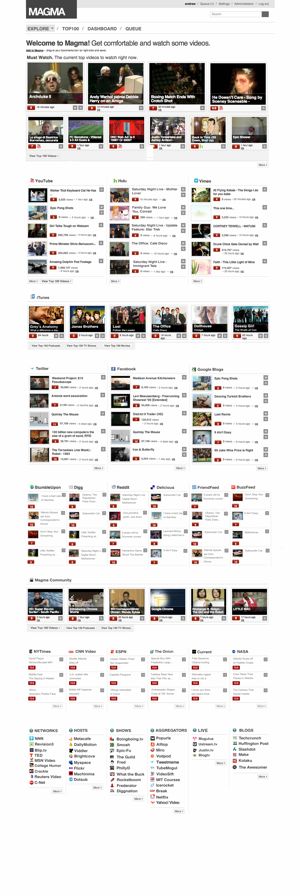 Andrew Baron, creator of groundbreaking video podcast Rocketboom unveiled his latest project, Magma, on Monday night at the NY Video 2.0 meeting. Magma is a video site – and a “trending topics” site – and a social community site, all in one place.
Andrew Baron, creator of groundbreaking video podcast Rocketboom unveiled his latest project, Magma, on Monday night at the NY Video 2.0 meeting. Magma is a video site – and a “trending topics” site – and a social community site, all in one place.
Baron explains that Magma is “is an entry point for online video”. The site “aggregates & tracks online videos from the top video hubs & tastemakers, measuring every number along the way. We cross-reference video statistics with social engagement data – blogs, twitter, & other social media chatter – and paint a real-time picture of a video’s spread across the web.”
Magma First Look
Magma basically tracks top videos across the internet, from a range of video and social platforms. The site lets you organize your videos in one place, and is a cool tool for checking online video popularity on a single site, or tracking top content in the aggregate of many sites.
Magma lists and tallies the current most-watched content on major video sites (YouTube, Vimeo, Hulu, iTunes). It also tallies video “chatter” on blogging and social networking sites like Facebook, Google Blogs and Twitter, and tracks buzz on social bookmarking sites like StumbleUpon, Reddit, delicious, FriendFeed, Digg, and BuzzFeed, as well as factoring in mentions in more “traditional” media like television, radio, newspaper, and magazine websites.
Also, any individual can add any videos or RSS feeds into Magma so that Magma will track those videos across the Internet as well.
All the buzz and views and chatter get tallied up and scored, and the hot “videos to watch right now” get displayed at the top of the home page.
There is also a whole community aspect of Magma with individual user profiles, and “the ability to collect videos, become a tastemaker/curator by building a community of people who like to watch the videos you aggregate.” Says Baron: “This is where things can get really interesting in terms of filtering and finding less popular videos that are more suitable to your personal interests.”
My quick assessment of Magma?
For viewers, the operative word here is top. Magma collects and tracks the top videos of the moment, at the top video portals and top social platforms. It takes a little poking around for an individual viewer to discover more obscure video gems that may be more worthwhile to her than what the aggregate (read: average) viewer liked. This may become easier if the site catches on, with more widespread use of the social/community features of the site.
For content creators, Magma could be a useful tool for tracking the popularity of their work on different sites, and for demonstrating that buzz to others. [See a sample statistics page for an individual video here.] Baron sees Magma as a platform-agnostic way for Internet video publishers “to direct their audience to show-off the most impressive viewpoint of surrounding buzz. (e.g. instead of sending their audience to a link on YouTube…)”
For prospective advertisers or sponsors of online video, (and for video producers, too), the statistical information generated by Magma is of great use and value. To be able to see data across a wide variety of sites, or from individual ones, will make better analysis possible, and facilitate smarter business decisions. Explains Baron, “most of our data is available through APIs so other statistical businesses, platforms and developers in general can use Magma’s data set to enhance their own projects.”
I would also like to have the ability to use Magma to track and aggregate viewer activity from an even wider range of video and social platforms.
The social aspect of Magma is appealing. Being able to share and collect recommendations from other Magma users is also a nice feature — but for people who already are reaching social overload, will they commit to cultivating a profile, and collecting friends’ information, on yet another site?
Magma is a site I will be keeping my eye on, because it has a combination of useful features that aren’t available in any other single location. I am imagining a number of ways Magma can foster and promote the growth of online video by providing a rich experience for video creators, consumers, and promoters/advertisers. I am hopeful that the couple of bumps I see in the site’s usability and focus can be easily ironed out.
Mizzou J-School Students: iPhone or iPod Touch Required
May 11th, 2009 | By Elisabeth Lewin | Category: Educational Podcasts, iPhone, iPods & Portable Media Players 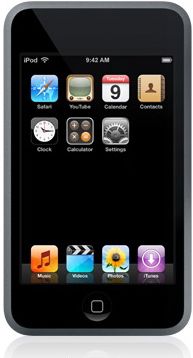 Used to be, the only tools aspiring journalists needed were pencils and a spiral notepad.
Used to be, the only tools aspiring journalists needed were pencils and a spiral notepad.
Then, in the last decade, journalism schools recommended that their students have access to a computer (preferably portable) and an Internet connection.
That seemed perfectly up-to-date in terms of media hardware, until today.
Now, at the University of Missouri Journalism School, “must have” reporting gear for the student reporter includes an iPod Touch or an iPhone.
Incoming freshmen in the School of Journalism will be notified over the summer about purchasing the iPhone or iPod Touch as the school’s “required media player.”
The devices will be used for podcast versions of lectures, which will be recorded and published with a new system being installed this summer.
Brian Brooks, associate dean of the Journalism School, told the school’s Columbia Missourian:
“Lectures are the worst possible learning format,†Brooks said. “There’s been some research done that shows if a student can hear that lecture a second time, they retain three times as much of that lecture.â€
The requirement will not be enforced, however, and there will not be a penalty for students who chose not to buy an iPod touch or iPhone, Brooks said.
“The reason we put required on it is to help the students on financial need,†Brooks said. “If it’s required, it can be included in your financial need estimate. If we had not required it, they wouldn’t be able to do that.â€
Brooks said students have the choice of just using their laptops to review lectures.
Bloggers like Valleywag’s Owen Thomas voiced outrage at the announcement, crying foul. By *requiring* the purchase of the media players, students can use their financial aid money to pay for their gear. “So basically, this is a scam to let students take out federally subsidized loans to buy iPhones,” Thomas rants.
Other pundits are complaining about the decision with the argument that it’s unfair to have a school supply list “with a pro-Cupertino [Apple products] bent.”
Apple bias and “federal subsidy” aside, does this equipment requirement make sense? It might be handy for cash-strapped students to be able to use financial aid money to get an iPod Touch or iPhone, but if their sole “academic” use is the download and replay of podcast lectures, a basic, less-expensive video-enabled iPod would certainly do the trick.
Will the idea of a required media player catch on at other schools? The iPod is, at many colleges, a recommended student purchase. It’s not a cheap gadget, but it doubles as a music repository, too. Lots of students already have iPods. And many institutions are making course lectures available as free podcasts on iTunesU.
And as far as the educational media device contest goes, it’s not limited to audio and video players. Last week, the new ($489) Amazon Kindle DX was unveiled. The big-screen e-book reader is being celebrated as a groundbreaking e-textbook solution. Trial programs will be underway this fall at Princeton and several other universities. It’s a great-looking device, but even more expensive and proprietary than the Apple hardware — before the students pay to load up the Kindles with their required course textbooks.
What hardware (if any) should be required for kids entering university?
Berklee Podcast Features All Kinds of Good Music
May 11th, 2009 | By Elisabeth Lewin | Category: Audio Podcasting, Podcast Quickies, Podcasting  The Berklee College of Music has a wonderful, eclectic music podcast that is worth checking out. The music school, based in Boston, is home to 4,000 students (and two record labels), and alumni run the gamut from Diana Krall to Melissa Etheridge, Quincy Jones to Aimee Mann, Howard Shore to John Mayer.
The Berklee College of Music has a wonderful, eclectic music podcast that is worth checking out. The music school, based in Boston, is home to 4,000 students (and two record labels), and alumni run the gamut from Diana Krall to Melissa Etheridge, Quincy Jones to Aimee Mann, Howard Shore to John Mayer.
The monthly “Sounds of Berklee” podcast reflects that eclectic range of musical genres and music-related professions. Some episodes feature noteworthy alumni (like producer Don Was), the musical projects of current faculty members and students, visiting lecturer/performers, and winners of Berklee-sponsored music contests. Podcast episodes are concise (under 10 min), and feature mostly music with very little talking.
More information about the “Sounds of Berklee” podcast can be found here, and you can subscribe here, or in iTunes here.
Grammar Girl’s Quick And Dirty Audiobook Nominated For Audie Award
May 8th, 2009 | By Elisabeth Lewin | Category: Audio Podcasting, Podcasting  Mignon Fogarty, podcasting’s “Grammar Girl,” has been nominated for an Audie Award, for the audio version of her book, Grammar Girl’s Quick And Dirty Tips For Better Writing.
Mignon Fogarty, podcasting’s “Grammar Girl,” has been nominated for an Audie Award, for the audio version of her book, Grammar Girl’s Quick And Dirty Tips For Better Writing.
The Audie Awards are sponsored by the Audio Publishers Association (APA), and “recognize distinction in audiobooks and spoken word entertainment.” The only awards program in the United States devoted entirely to honoring spoken-word entertainment, the Audies competition drew in a record 1,000 entries from audio publishers this year.
Fogarty’s Quick and Dirty Tips for Better Writing book, like her popular podcast, offers simple explanations of some of the most common mistakes people make while communicating.
In addition to creating the Grammar Girl podcast and book, Fogarty is also at the head of a small podcasting empire, with ten different podcast series of Quick and Dirty Tips ranging from money and parenting, to manners and marketing.
I asked Fogarty to tell me more about the Audie nomination:
“The full-length audiobook version of my print book, Grammar Girl’s Quick and Dirty Tips for Better Writing, has been nominated for an Audie Award–the Oscars of the audiobook world. It is nominated in the Business/Educational category.
“I recorded the book over two days in a professional studio in San Francisco. It was a challenge to record for two days straight when my voice is only used to doing a five- to eight-minute podcast, so I’m very pleased to be nominated!”
Winners will be announced at The Audies gala on May 29, 2009 at the New-York Historical Society in New York City.
Podcasting, Defined.
May 8th, 2009 | By Elisabeth Lewin | Category: Podcast Quickies, Podcasting, Video Podcasts
For nearly five years and counting, we’ve been creating, and writing about, podcasts. We know what podcasts are, and chances are, you do, too. We love them, and think they are super-neat.
We think everybody ought to create podcasts, because they help you:
- share your passion and expertise widely, and
- connect, over long distances, with like-minded people.
Simple, right?
But explaining podcasting to someone else? It’s tricky. You have to craft your simple explanation to accommodate how technical (or not) the other person is. Explaining podcasting to someone who is technologically minded, whether a programmer, a blogger, or even a musician, they usually get it. (Mostly.)
But trying to explain podcasting to somebody less technically-minded? Someone who still hasn’t set the clock on their 1989 VCR? Not so simple.
Into the fray comes “Emily Explains It.” Little Emily Chapman, daughter of pioneering podcaster C.C. Chapman, has a new video podcast series, in which she answers viewers’ questions.
Episode one is entitled, “What is a podcast?” She does a marvelous job with a very straightforward, simple answer to the question. She doesn’t get bogged down explaining the technical details, but does an excellent job explaining the basics:
“A podcast can be many different things: a video, or just like the radio, or… a friend of my dad’s writes down stories and then reads them out and then people can listen to the stories. You can play them on the iPod but you don’t need an iPod to listen to podcasts.”
Emily has another fun episode about Websites I Like, which mostly is an excellent, brief discourse on Webkinz, which, if you’re in second or third grade, is indeed a wonderful place.
Satellite Radio Faces Sirius Problems
May 7th, 2009 | By Elisabeth Lewin | Category: iPhone, The New Media Update  Satellite radio network Sirius XM Radio released grim first-quarter results today, with a drop in both subscribers and revenues.
Satellite radio network Sirius XM Radio released grim first-quarter results today, with a drop in both subscribers and revenues.
Sirius has recently created a new service that can stream radio content via Apple devices like the iPhone and the iPod Touch, but that innovation may be too little, too late, to staunch the hemorrhage of customers.
In a world where free content proliferates in the form of free Internet radio and free podcasts, is (paid) satellite radio content irrelevant?
The company, which resulted from the merger last of two competing satellite radio providers, had a decline of 404,000 subscribers from the previous reporting quarter. Many new subscribers to the radio service have historically come from new car purchases with built-in satellite receivers. With the slump in automotive sales, the company predicts a “noticeable hit” to subscription rolls over the next quarter as well.
Sirius also reported a loss of $236 million in the first quarter, or 7 cents a share, compared with last year’s first-quarter loss of $104 million. $186 million of the loss was related to stock issued to Liberty Media Group earlier in the year, as part of Liberty’s $530 million loan to Sirius, which in turn helped the satellite company stave off declaring bankruptcy.
Somehow, the company remains optimistic about the long-term outlook for satellite radio. Despite expected continued subscription losses, they have raised their forecast for 2009 adjusted income from $300 to $350 million, as a result of “cost-cutting measures.” Mel Karmazin, CEO of Sirius, also expects to meet a goal of over 20 million subscribers by the end of this year.
In an upbeat statement that flies in the face of the hard numbers and analysts’ assessments, Karmazin says that “satellite radio is now a cash flow growth story.â€
MobaTalk Service Adds Context to Microblogging
May 7th, 2009 | By Elisabeth Lewin | Category: Microblogging 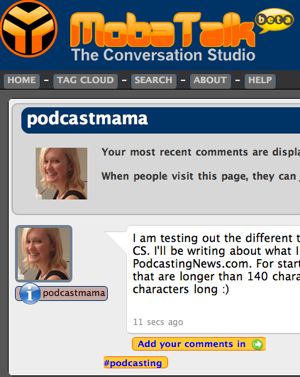 Developer Michael Bailey has launched a new microblogging media-sharing site, MobaTalk.
Developer Michael Bailey has launched a new microblogging media-sharing site, MobaTalk.
The site is an online service built for sharing more detailed information in a “micro” format, preserving what Bailey, creator of the MyChingo Audio Comment System, calls “the contextual association” of the content.
MobaTalk accommodates submissions of short video (under 2 min), or audio files, images, links, embedded media or text (up to 500 characters). Users of the site choose a hash-tagged category from a master list of topics, or create their own. The hashtag then is attached to the user’s post, and appears in the person’s Twitter stream or on Facebook.
MobaTalk’s ability to accommodate longer text posts, and posts of other media, is exciting. While Twitter is a great way to share information, the microblogging service has limitations that make communicating the full idea and its context. This may be a good solution for adding depth to the medium.
I took a cursory look around the site, and found that there wasn’t a #podcasting hashtag yet. I easily created one, and typed a (>140 character) post about it, which looked like the picture, right.
That post then appeared in my Twitter-stream, looking like this:
The MobaTalk Conversation Studio is available for use by anyone who has an account with Twitter.com; no registration is required.
Kindle DX: First Impressions From Kindle Chronicles’ Len Edgerly
May 7th, 2009 | By Elisabeth Lewin | Category: Computer Hardware, iPods & Portable Media Players  Wednesday online book retailing giant Amazon.com unveiled the newest version of the Kindle e-book reader.
Wednesday online book retailing giant Amazon.com unveiled the newest version of the Kindle e-book reader.
The new model, the Kindle DX, is a bigger-screened, more expensive version ($489!) of Amazon’s popular gadget. The DX is thin and light, can display more shades of gray (perfect for b/w newspaper and magazine content), and, says InformationWeek, it “shows crisper graphics and text without the eyestrain and glare associated with the backlight used in laptops.”
The larger 9.7 inch screen is also geared toward a new use for the Kindle, which they also discussed at the product introduction on Wednesday: the display of electronic versions of textbooks, opening up the Kindle to the lucrative high school and college markets.
To get a more detailed overview and analysis of the new book-reader, we touched base with a Kindle expert. Len Edgerly, creator and host of “The Kindle Chronicles” podcast, had this to say:
Elisabeth, I’m impressed that Amazon has lined up textbook publishers representing more than 60 percent of the textbook market, according to the company’s press release accompanying the announcement of the Kindle DX.
The publishers are Cengage Learning, Pearson, and Wiley. Amazon reported that textbooks under the following brands will be available: Addison-Wesley, Allyn & Bacon, Benjamin Cummings, Longman & Prentice Hall (Pearson); Wadsworth, Brooks/Cole, Course Technology, Delmar, Heinle, Schirmer, South-Western (Cengage); and Wiley Higher Education. That’s a pretty strong lineup, and it convinces me that the main strategic purpose of the DX is textbooks, not newspapers.
Amazon CEO Jeff Bezos dropped a real bombshell at the press conference when he announced that for books available on the Kindle, sales are already 35 percent of the same books in print, up from 13 percent just a few months ago. The chart he showed looked like the proverbial hockey stick, with a dramatic surge in the share of Kindle sales beginning with the launch of the Kindle 2 in February. This confirms my sense that Kindle sales were soaring this year, even before the DX debut.
As for the DX itself, the big news may be the PDF capability. My hunch is that business users will find this new Kindle attractive for reading work-related documents while traveling or at home. It could certainly become the reader of choice for lawyers, saving them the work of hauling fat briefcases bulging with depositions. I see that the DX will weigh twice as much as the current Kindle, but the larger screen is certainly going to be an advantage for some kinds of reading, especially textbooks and maybe newspapers.
Will the DX save newspapers? I doubt it. The potential circulation numbers at this point are too small. But it’s certainly got to be a hopeful development for struggling icons like the New York Times and the Boston Globe, both of which (and the Washington Post) signed up for yet-to-be-detailed promotions in which they will offer discounts on Kindle DX’s if you people sign up for long-term subscriptions.
All in all, it was an exciting day. I preordered my DX the minute I saw someone Twitter the link to the Amazon page. I hope Amazon underpromised and will overdeliver in terms of the shipping date, so that I’ll get my hands on my DX maybe in June instead of August.
I’ll have more thoughts about the DX in this week’s episode of The Kindle Chronicles, which I’ll upload on Friday.
